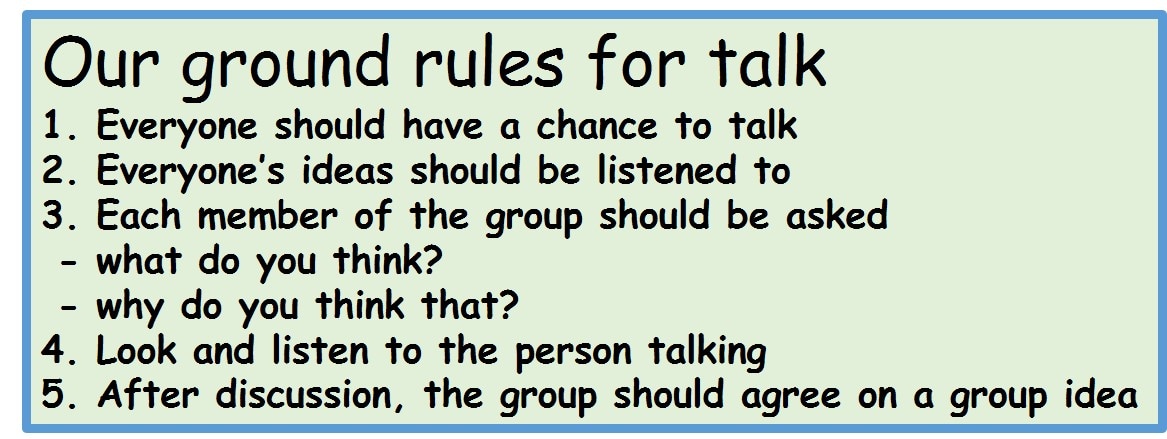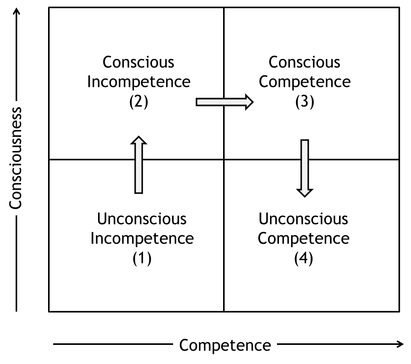The Thinking Together approach to teaching dialogue relies on teaching learners ‘ground rules’ for talk. But what exactly are these ‘ground rules’? The term ‘ground rule’ originated with base-ball in America. Every base-ball ground was a bit different and had to have their own ground rules in addition to the universal rules. For instance a ground rule that applies at Fenway Park, the home of Boston Red Sox, is that: A fly ball that strikes the top of the ladder on the Green Monster and then bounces out of play is two (2) bases. These are explicit rules and so quite misleading when it comes to the use of the term ‘ground rule’ in dialogic education. Here the Oxford English Dictionary definition is a better guide. This describes a ground rules as ‘a basic principle’ and gives as one example of use: ‘My first ground rule is always to tell the truth.’
So exactly what kind of thing are these ‘ground rules’ again?
The use of the term 'ground rule' for teaching dialogue is a version of the rules suggested by 'conversational implicature' in pragmatics (Grice, 1975). Conversational implicature concerns the assumptions that people make, and often have to make, in order to interpret what others say in a dialogue. For example we normally assume that what another person says is relevant so if I ask 'where are the keys?' and my son says 'on the table' I can just assume that he means the car keys I am looking for as I am about to leave the house and that he means that they are on the nearest and most obvious table to both of us. Of course there are lots of misunderstandings but that is why we know that the rules of implicature apply because we can see the assumptions being made that generate the misunderstandings. 'They are not on the table!', 'Yes they are - I didn't mean the big table, I meant the small table in the hall' etc.
Implicature in dialogues is interesting because it suggests that explicit meaning rests upon a larger background of shared implicit assumptions. It is only because we have a shared 'form of life' as Wittgenstein put it that people can make sense of what each other are saying. The set of implicit assumptions vary across cultures and change over time. They depend on who we think we are and what we think we are doing. More than that, if we do not question them and take conscious responsibility for them, they determine who we think we are and what we think we are doing. Foucault has argued, for example, that it is not so much that subjects (us) speak the discourse - as we tend to assume - but rather it is the other way around, the subjects - i.e us - are spoken by the discourse.
Ground rules need to be shared. If one person had a set of implicit assumptions that she used to interpret the meaning of utterances and no one else shared those then they would not be ground rules. While ground rules might be found reflected in neural activity in individual brains – but then again, what isn’t? – their primary nature is to be shared and social. They are not material objects found in physical space. Ground rules are invisible features of dialogic space. Dialogic space is that meaning space shared between people in dialogue together. When ground rules are made explicit, written down on cards and discussed together, then they are part of the contents of dialogic space. Anything that enters into dialogic space can be seen from multiple perspectives. It becomes a sign in an ongoing dialogue with a meaning that evolves as the dialogue moves on. However, before they are made into objects of shared attention, before they are written down, they are hidden in the background. Ground rules originate as part of the invisible architecture of dialogic space. Although, as I have argued elsewhere, dialogic space always has an infinite potential for generating new meaning, in practice any given dialogue has a hidden architecture that shapes what is likely to be said and what is likely to be thought.
Tom: It’s that one
Shane: No, it’s not
Tom: Yes, it is
Shane: I got it right
Tom: No you didn’t
Shane: I won. I am the best
Tom: You're just a d**khead
(2 boys playing a video game)
It is easy to see here simple ground rules at play of the kind that Neil Mercer referred to as characteristic of ‘disputational talk’. Ground rules like ‘always disagree’, ‘try to win’, ‘do not admit to learning anything from the other’. The simple ground rules here are not reducible to the visible words spoken. Those words are, in a sense, generated by the ground rules. Although the ground rules are invisible behind the surface of the talk they are quite close to the surface and easy to discern behind it.
References and links to follow up
Sources for practical advice on how to teach ground rules for thinking together:
Phillipson, N., & Wegerif, R. (2016). Dialogic Education: Mastering core concepts through thinking together. Routledge.
Dawes, L., Mercer, N., & Wegerif, R. (2004). Thinking together: A programme of activities for developing speaking, listening and thinking skills for children aged 8-11. Imaginative Minds.
http://thinkingtogether.educ.cam.ac.uk/
Bhaskar, R. (2013). A realist theory of science. Routledge.
Cox, B., & Forshaw, J. (2013). The Quantum Universe:(and why Anything that Can Happen, Does). Da Capo Press.
Grice, H. P. (1975). Logic and conversation. 1975, 41-58.
Hedström, P., & Ylikoski, P. (2010). Causal mechanisms in the social sciences. Annual Review of Sociology, 36, 49-67.
Kant, I. (1781/1998). Critique of Pure Reason (translated and edited by Paul Guyer & Allen W. Wood).
Mercer, N. (2000). Words and minds: How we use language to think together. Psychology Press.
Merleau-Ponty, M., (1968). The visible and the invisible: followed by working notes. Northwestern University Press.
Links:
https://en.wikipedia.org/wiki/Four_stages_of_competence
https://plato.stanford.edu/entries/abduction/peirce.html
Note on picture. Some have cited this picture as the correct set of ground rules for talk. This is a misunderstanding. Rules work in contexts. This was an actual set of rules developed by a class that we worked with in Milton Keynes in the 1990s and it was useful for them at that time with a focus on work around computers. Where there is only one mouse and a group of students agreement is essential but this is not always the case. Out of interest, the ground rules currently used as a guide for teachers in the Cambridge T-SEDA programme are as follows:
We listen without interrupting when others are speaking
Contributions respond to what has gone before
It’s ok to disagree with someone
People give reasons for their ideas
Everyone’s ideas and opinions are treated with respect
Taking part means thinking and listening, not just talking
People ask each other questions
There is an atmosphere of trust
There is a sense of shared purpose



 RSS Feed
RSS Feed